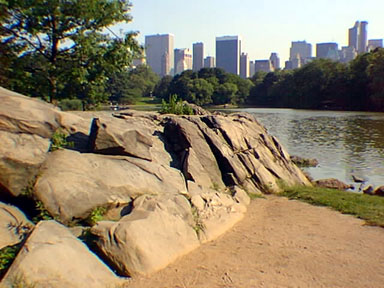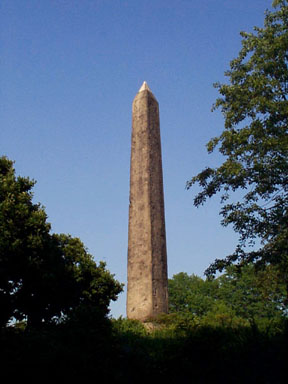1. Central Park, Manhattan Island
Central Park occupies an area of 840 acres and extends between 59th and 110th streets between 5th Avenue (Central Park East) and 8th Avenue (Central Park West). The park is considered one of the greatest achievements in artificial urban landscaping. Most of the park land was purchased in 1856 at a price of $5,000,000. The layout was designed by Frederick Law Olmstead and Calver Vaux to, in part, "preserve and enhance" the natural features of the terrain. Construction of the park took twenty years, and involved the draining of swamps, planting of trees, contouring the landscape, and the importation of soil of good quality to cover the existing poor, rocky alluvium. Central Park was officially opened in 1876.
Central Park is a popular site for geology field trips in the New York City area, and for good reason. The park is extremely accessible and is close to many museums, including the American Museum of Natural History (79th and Central Park West). Exposures of the Cambrian Manhattan Formation (or Manhattan Schist) crop out throughout the park, particularly throughout its southern end. Features of geologic interest include a variety of metamorphic rock features, glacial features, and the urban setting of the park itself.
The best way to examine the geology is to plan a circuit walk around the south
and central portions of the park. Large outcrops of crenulated schist and gneiss
are scattered throughout the tailored landscape. Many of the exposures preserve
glacially-polished surfaces, striations, and grooves carved from rocks embedded
in the base of the ice sheet as it moved southward. Although most of the glacial
erratics have been removed, some remain scattered among the undeveloped portions
of the park, particularly on many of the large barren exposures of bedrock and
around the park ponds. Some have been incorporated into garden walls and bridges
within the park. Most erratics are pieces of the Cambrian Manhattan Formation
derived from sources nearby, whereas others have been transported much greater
distances. The most obvious are large, dark boulders of diabase derived from
the Palisades Sill of Jurassic age which crops out along the western side of
the Hudson River.
The glacially polished surfaces provide opportunity to examine weathering rates
of rock. The more resistant quartz-rich layers tend to stand out and maintain
their glacial polish, whereas faster-weathering bands of feldspar and mica are
recessed. Fractures in many outcrop exposures are progressively being forced
open by the expansion of roots and the forces generated by cycles of freezing
and melting of ice (Figure 14).
 |
| Figure 14. A view of a glacial scoured outcrop of gneiss and schist of the Manhattan Formation exposed by The Lake on Central Park's west side. The skyline of Midtown dominates the horizon. |
Cleopatra's Needle, an Egyptian obelisk, has been used for illustration of weathering processes in numerous geology textbooks (Figure 15). The obelisk was donated to the United States and erected at its site on the west side of the Metropolitan Museum of Art in 1881. The monument is easy to find by following any number of park trails that lead toward the southwestern side of the museum. The monument's name, Cleopatra's Needle," is somewhat of a misnomer. Inscriptions on the monument include the names Thutmose III and Rameses II from the 12th Century BC (more than 11 centuries before Cleopatra). The obelisk is carved from a single piece of red granite derived from a quarry at Aswãn, and weighs about 224 tons. The surface of the stone is heavily weathered, nearly masking the rows of hieroglyphs engraved on all sides. Photographs taken near the time the obelisk was erected in the park show that the inscriptions were still quite legible. The stone had lain in the Egyptian desert for nearly 3000 years but undergone little weathering. In a little more than a century in the climate of New York City, pollution and acid rain have heavily pitted its surfaces.
 |
| Figure 15. Cleopatra's Needle, a weathered Egyptian obelisk near the Metropolitan Museum of Art. |
| Return to the Highlands Province Main Page. |